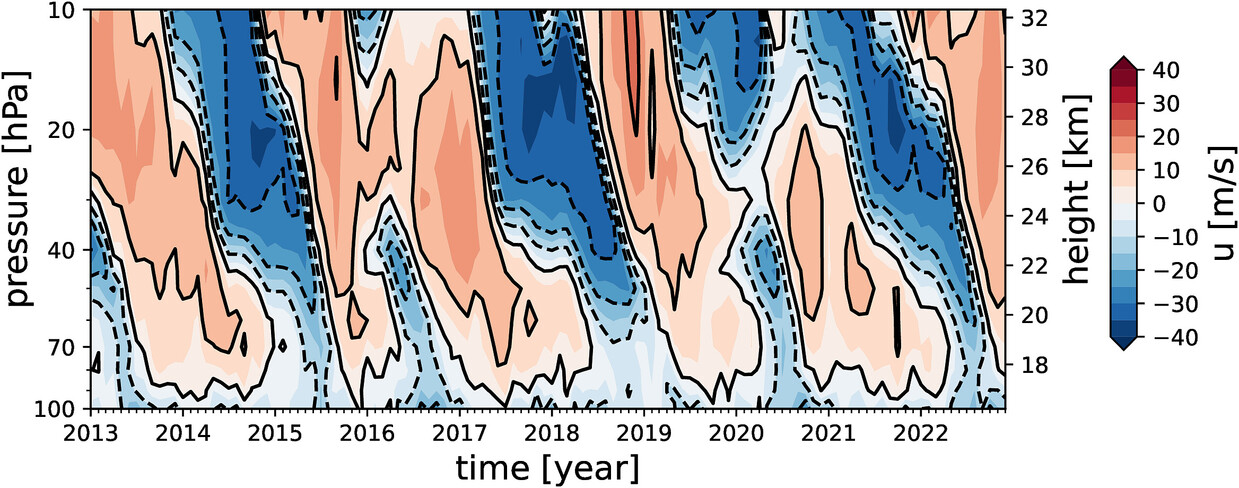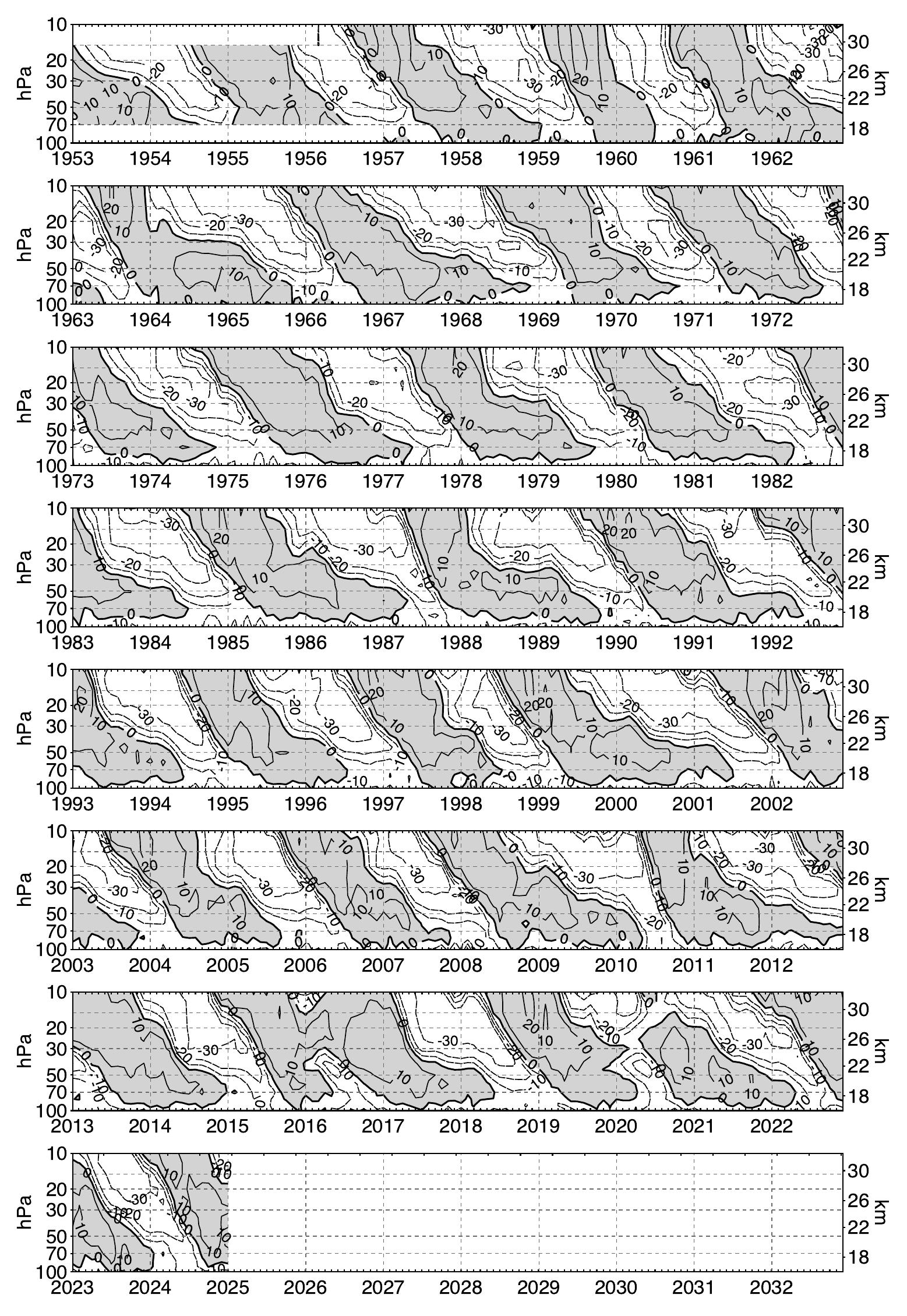The Quasi-Biennial-Oscillation (QBO)

FU BERLIN QBO-TIMESERIES becomes KIT QBO-TIMESERIES
The Institute of Meteorology and Climate Research at the Karlsruhe Institute of Technology (KIT) is happy to announce that the Berlin QBO-timeseries of the FU Berlin Atmospheric Dynamics (and Stratosphere) research group will be continued. At KIT, the QBO will be calculated based on the original method of analysis developed at FU Berlin. The FU Berlin QBO timeseries will thus be continued in a consistent manner into the future.
The QBO is characterized by the downward propagation of alternating easterly (westward) and westerly (eastward) zonal wind bands in the tropical stratosphere between approximately 100 hPa and 10 hPa. It manifests itself as an 22 to 34 month long oscillation of the direction of the zonal-mean zonal winds at a given altitude, with an average of approximately 28 months. The QBO is caused by the interaction of breaking waves with the zonal mean flow where a mixed spectrum of (Rossby) gravity waves produces an easterly acceleration and Kelvin waves in the lower stratosphere provide an upward flux of westerly momentum responsible for a westerly acceleration (Lindzen and Holton, 1968; Holton and Lindzen, 1972; Dunkerton, 1997; Baldwin et al., 2001).
The QBO's existence was first suggested by Graystone (1959) based on radiosonde data, and its alternating wind patterns were subsequently confirmed by Ebdon (Ebdon, 1960, 1961a,b; Veryard and Ebdon, 1961) and independently by Reed et al. (1961). The first modeling attempts for the QBO were presented in Reed (1964).
Baldwin et al. (2001) provided a comprehensive review of the QBO's dynamical and global impacts, highlighting its influence on stratospheric ozone distribution, tropospheric circulation patterns, and even the timing of sudden stratospheric warmings. Marquardt (1998) investigated the coupling between the QBO and the global stratospheric circulation, demonstrating their interconnectedness in shaping atmospheric dynamics.
Data Compilation
More than 70 years ago, the Quasi-Biennial Oscillation (QBO) of the winds in the equatorial stratosphere was detected due to the establishment of a global, regularly measuring radiosonde network (Graystone, 1959; Ebdon, 1960).
As part of the compilation of our daily stratospheric charts we have tabulated the daily wind observations of selected stations near the equator since 1957. For the earlier years, the values were extracted from the Northern Hemisphere Data Tabulations. From these daily values the monthly mean zonal wind components were calculated for the levels 70, 50, 40, 30, 20, 15, and 10 hPa and a data set from 1953 to the present was produced by combining the observations of the three radiosonde stations Canton Island (closed 1967), Gan/Maledive Islands (closed 1975), and Singapore (data file: qbo.dat).
This data set is supposed to be representative of the equatorial belt since all studies have shown that longitudinal differences in the phase of the QBO are small. It should be noted, however, that some uncertainties arose at higher levels during the early years from the scarcity of observations. More information on the original data can be found in Naujokat (1986).
A second data set has been produced since 1987 from the Singapore data by using the daily vertical wind profiles to obtain a higher vertical resolution. In this set you will find the monthly mean zonal wind components at Singapore for every year from 1987 to the present at the levels 100 (since 1997), 90, 80, 70, 60, 50, 45, 40, 35, 30, 25, 20, 15, 12, and 10 hPa (singapore.dat).
Data Access
The datasets (as ASCII-encoded text) can be obtained here. The archive files (*.zip and *.tar.gz) contain the files: qbo.dat, singapore.dat, and singapore2025.dat:
- qbo.dat
- singapore.dat
- singapore2025.dat
- radiosonde_tropical_eastward_wind_195301-202512.nc
- qbo_data_tgz.tgz
- qbo_data_zip.zip
- netCDF file on zenodo
The QBO time series is updated until December 2025.
For questions concerning the QBO data series please contact Tobias Kerzenmacher: kerzenmacher∂kit.edu.
Structure of the QBO
The time-height section derived from these data in Fig.30 shows the observed structure of the QBO at equatorial latitudes:
- alternating easterly and westerly wind regimes propagate downward with time;
- westerlies move down faster and more regularly than easterlies;
- the transition to easterlies is often delayed between 30 and 50 hPa;
- easterlies are generally stronger (30-35 m/s) than westerlies (15-20 m/s);
- maximum amplitudes of both phases typically occur near 20 hPa;
- the average period is about 27 months;
- both period and amplitude considerably vary from cycle to cycle.
Detailed information on all aspects of the QBO, its dynamics and its global effects, can be found in a most recent review paper of Baldwin et al (2001), including a comprehensive bibliography. A study of the coupling between the tropical QBO and the global stratospheric circulation has been performed by Marquardt (1998).
References
Baldwin, M.P., L.J. Gray, T.J. Dunkerton, K. Hamilton, P.H. Haynes, W.J. Randel, J.R. Holton, M.J. Alexander, I. Hirota, T. Horinouchi, D.B.A. Jones, J.S. Kinnersley, C. Marquardt, K. Sato, and M. Takahashi, 2001: The Quasi-Biennial Oscillation. Reviews of Geophys., 39, 179-229.
Ebdon, R. A. , 1960: Notes on the wind flow at 50 mb in tropical and sub-tropical regions in January 1957 and January 1958. Q. J. Roy. Met. Soc., 86, 540-542.
Graystone, P., 1959: Meteorological office discussion on tropical meteorology. Met. Magazine, 88, 117.
Holton, J. R. and R. S. Lindzen (1972): An updated theory for the quasi-biennial cycle of the tropical stratosphere. J. Atmos. Sci., 29 , 1076-1080.
Lindzen, R. S. and J. R. Holton (1968): A theory of the Quasi-Biennial Oscillation of the tropical stratosphere. J. Atmos. Sci., 25, 1095-1107.
Marquardt, C. and B. Naujokat, 1997: An update of the equatorial QBO and its variability. SPARC Melbourne, WMO/TD-NO. 814, 87-90.
Marquardt, C., 1998: Die tropische QBO und dynamische Prozesse in der Stratosphäre. PhD Thesis, Met. Abh. FU-Berlin, Serie A, Band 9/Heft 4, Verlag Dietrich Reimer Berlin, 260 S.
Naujokat, B., 1986: An update of the observed quasi-biennial oscillation of the stratospheric winds over the tropics. J. Atmos. Sci., 43, 1873-1877.
Reed, R. J., Reiter, E. R., & Sheretz, D., 1961: The structure and dynamics of the upper troposphere and lower stratosphere at 30°N. Journal of the Atmospheric Sciences, 18(5), 403-420.
Contact
For questions concerning the QBO data series please contact: Tobias Kerzenmacher (kerzenmacher∂kit.edu).
Acknowledgements
This dataset has many contributors. It was originally created by Barbara Naujokat, who worked in Karin Labitzke's research group. Later, the project was continued by Markus Kunze. The new radiosonde data was provided by Pei Yi Leong and Dahlan Samubari.

